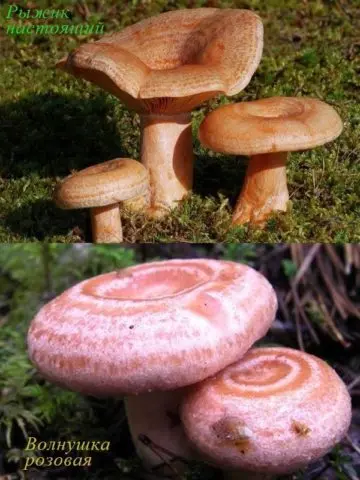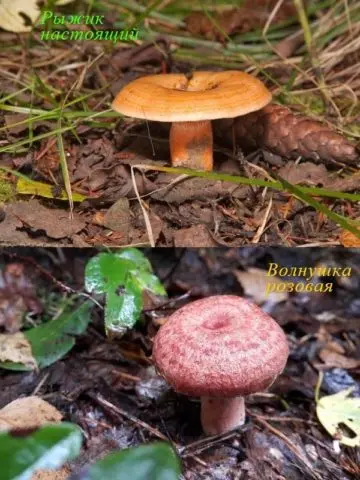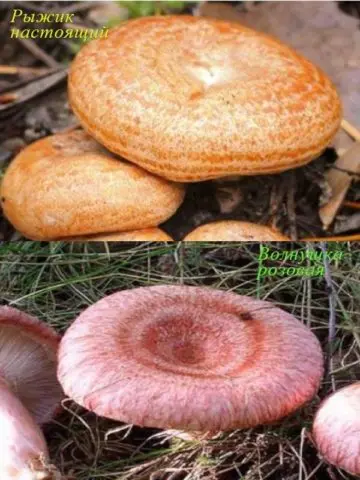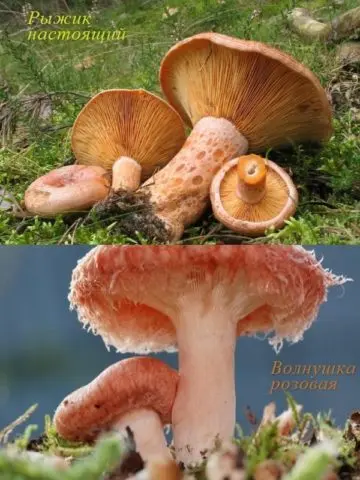Contents
- What types of mushrooms and mushrooms are often confused by mushroom pickers
- What do mushrooms and waves look like
- What is the difference between mushrooms and waves in appearance
- How to distinguish saffron mushrooms from mushrooms by size
- Ryzhik and volnushka: differences in the habitat
- How to identify waves or mushrooms by pulp
- How to distinguish a camelina from a wave during heat treatment
- Mushrooms mushrooms and volnushki: the difference in taste
- The difference between mushrooms and volnushki for use in cooking
- What is the difference between saffron mushrooms and mushrooms in terms of useful properties
- How are mushrooms similar
- How to distinguish between mushrooms and waves when collecting
- Conclusion
Mushrooms and volnushki are “close relatives” in the world of mushrooms, which are often confused with each other. However, with all their external similarity, they differ significantly from each other in a number of qualities. The difference between mushrooms mushrooms and mushrooms, first of all, is that the former are edible and are famous for their excellent taste, while the latter, due to their caustic bitter juice, can only be eaten after pre-soaking. Volnushki are easier to find in the forest, but mushrooms are much more desirable prey for a mushroom picker. What they have in common and what are the differences, it is worth considering in more detail.
What types of mushrooms and mushrooms are often confused by mushroom pickers
Both mushrooms and volnushki are two groups of agaric fungi belonging to the Mlechnikov genus. Of the several existing species, the first most often found in forests are real mushrooms, or pine ones. Most often, lovers of “silent hunting” confuse young specimens of these mushrooms with the largest and most common of the waves – pink.
What do mushrooms and waves look like
The external similarity of waves and mushrooms is clearly visible in the photo:
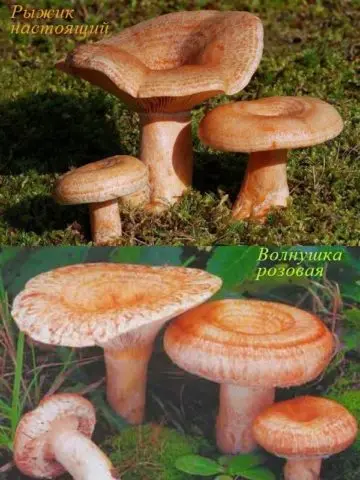
They differ little in size (cap diameters vary from 3 to 18 cm, legs are 3-6 cm long and 1-2 cm thick). Their hats are painted in shades of red, have a similar funnel shape, on the surface you can distinguish darker concentric circles – “waves” that run from the center to the edges. The pulp is brittle, fragile, at the break it releases a thick “milky” juice. With a cursory superficial examination, the differences between these fungi are hardly noticeable.
What is the difference between mushrooms and waves in appearance
At the same time, if you look at the photo more closely, it becomes clear how mushrooms differ from waves.
Of the external features of these mushrooms, one can note:
- The tone of the skin of the wave is pink. Ryzhikov, as a rule, are distinguished by bright orange shades.

- At the waves, the caps are covered with small villi and look very “pubescent”. In saffron milk caps, they are smooth or slightly felty in appearance.

- The shape of the cap of a young wave resembles a hemisphere with edges rounded downwards. As for young mushrooms, their hat is flat, the edges are almost not rounded.

- Circles on the surface of the caps of the waves are usually clearly visible. In redheads, they do not stand out so clearly.

- The leg of the wavelet is usually somewhat thinner and smoother, without dents.

A clear illustration of how similar and how these mushrooms differ externally will be this material:
How to distinguish saffron mushrooms from mushrooms by size
Size is another criterion that helps to recognize whether there are waves in front of the mushroom picker or mushrooms. The difference is not very noticeable, but it is there: the latter are slightly larger. The cap of a real camelina usually grows up to 5-18 cm in diameter. In a pink wave, it is smaller: 3-10 cm (occasionally reaches 15). But since most often you can find groups of young mushrooms with hats from 5 to 10 cm, it is difficult to understand how they differ solely on this basis. Other characteristics must also be taken into account.
Ryzhik and volnushka: differences in the habitat
The picking season for mushrooms and mushrooms coincides and lasts a long time – from about the end of June to the end of October. However, it is possible to distinguish these mushrooms from each other, focusing on which places in the forest both prefer.
So, the “favorite” tree of pink waves is birch. It is with her that these fungi most often form mycorrhiza. They grow in mixed and deciduous forests, usually found in large “families” under aspens or on the edges in the middle of thick grass.
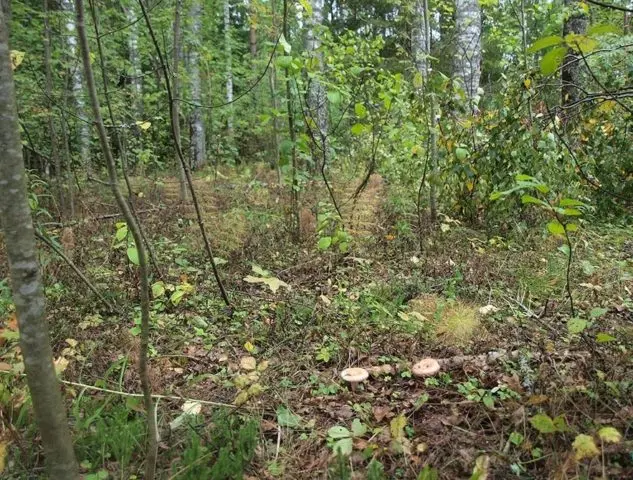
The real ginger is also called upland or pine. Among his preferences are coniferous forests with dry soils. At the same time, this fungus is very capricious about the cleanliness of the environment: it practically does not grow in polluted places.
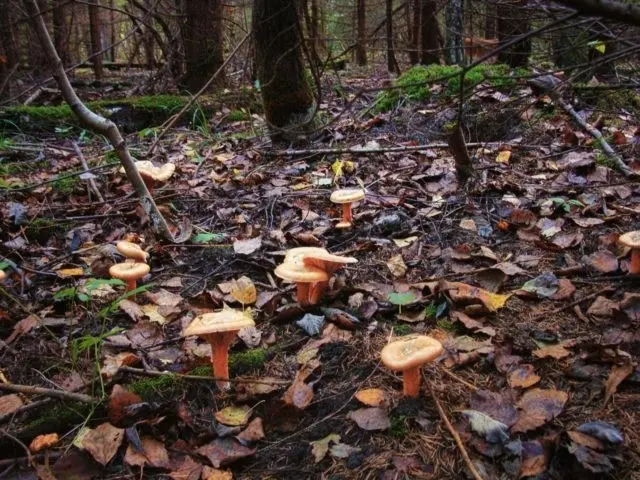
How to identify waves or mushrooms by pulp
A number of reasons for the difference can be obtained by cutting the fungus of interest. In the photo below – the pulp of mushrooms and waves. In these mushrooms, it is dense and brittle, with a faint smell of resin, but the similarity ends there. The pulp of saffron milk caps is orange, rarely white-yellow. In waves, it is white, cream or pale pink.
Thick juice, reminiscent of milk and abundantly protruding at the break of the fruiting body, in saffron milk mushrooms is yellow or orange, bright. It leaves a red mark on his fingers. It is not at all burning, a little spicy and even sweet in taste. At the same time, the juice of the volnushki is milky white or pale yellow, very caustic and bitter.
The smell of camelina pulp at the fracture point is pleasant, fruity, with hints of sweetness. The pulp of the pink volnushka smells sharply, bitterly, a bit reminiscent of geranium.
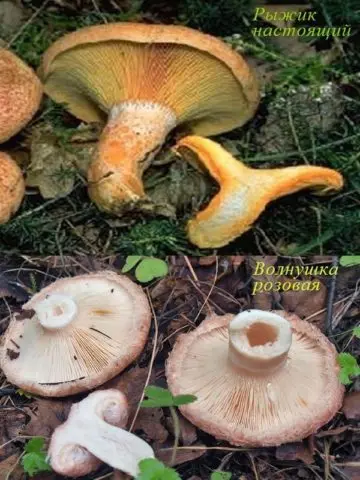
What is the difference between a saffron milk cap and a wave in color on a cut
It is also curious to observe what color the flakes and edible mushrooms are, if you cut these mushrooms and let them lie down in the air for a bit.
The orange flesh of the camelina at the site of damage very quickly turns red. Pigmentation is formed due to the fact that certain substances in its composition are oxidized under the influence of air. Over time, the flesh in the crack will change color to a grayish green, just like the dried juice of this mushroom or a place that has been pressed hard.
The pulp and juice of the volnushka in the air do not change their color. In the same way, the color of the part of its fruiting body does not change when pressed.
How to distinguish a camelina from a wave during heat treatment
Boiled or fried camelina darkens. When salted, it can change color to green. In most preparations, these mushrooms, as a rule, retain their orange color. They do not need long heat treatment.
Before preparing a dish of waves, be sure to soak them, and then boil them in boiling water. When boiled, the flesh of this mushroom becomes light gray.
Mushrooms mushrooms and volnushki: the difference in taste
Taste is another significant difference between camelina mushroom and volnushka. The first of them is not without reason also known as “delicacy”. Since ancient times, these mushrooms have been famous for their excellent taste and pleasant spicy smell, which persists regardless of the form in which they were decided to cook. It is interesting to note that salted mushrooms were exported in significant volumes from the Empire to a number of European countries, where recognized gourmets have always valued them very highly.
As for the wave, it is somewhat inferior to its elite “brother” in taste and nutritional value. In its raw form, it is not consumed because of the bitter, unpleasant juice and toxic substances inherent in its pulp in its raw form. After preliminary preparation, a number of dishes are successfully obtained from this mushroom.
The difference between mushrooms and volnushki for use in cooking
There is a difference in how it is recommended to cook mushrooms and mushrooms. It manifests itself at the stage of pre-processing.
Freshly picked or just bought volushki should be washed well in cold water, the hats should be cleaned of the “fringe”, the lower third of the leg should be cut off. Large specimens should be divided into 3-4 parts. Then these mushrooms must be soaked for 3 days in clean cold water, changing it every 4-6 hours. This treatment allows you to save their flesh from bitterness and toxic substances that can cause poisoning.

Ryzhik does not require such serious preparation measures. It is enough to rinse them with high quality in a container with cold water, cut off the lower parts of the legs, put them in a colander and pour them over again with running water from the tap. It is not necessary to soak them for a long time, although some housewives still leave these mushrooms in salted water for 20-30 minutes before cooking.
Mushrooms are truly versatile mushrooms. From them you can cook almost anything. In the old days, small young specimens of these mushrooms were even eaten raw, simply sprinkled with coarse salt and kept for a couple of hours. Today they are boiled, fried and stewed, fermented, salted and pickled, an extract (essence) is obtained from them, and they are also prepared for future use in dried and frozen form. It is worth knowing that these mushrooms are the only ones that can be salted in the so-called “dry” method (putting them in a container without rinsing with water and pouring salt in layers, and then placing them in a cellar under oppression for 10-15 days).

The range of culinary uses of the waves is less extensive. They are most often pickled or salted in one of two ways: cold (without heat treatment) or hot, rolled up in jars under tin lids. Before the harvesting procedure, these mushrooms, as a rule, are blanched in boiling water, be sure to drain the first broth. Salty volnushki are used for food no earlier than after 1,5 months. These mushrooms are also served boiled or fried. It is forbidden to taste them raw. In addition, they are not dried or frozen.

What is the difference between saffron mushrooms and mushrooms in terms of useful properties
Like many other mushrooms, both milky mushrooms are a low-calorie product with a rich chemical composition, which, when properly prepared, has a beneficial effect on the human body. However, the content of nutrients in the pulp of saffron milk mushrooms and volushki is not the same.
The first is characterized by a large amount of beta-carotene, which is necessary to maintain good vision. Also, mushrooms contain many useful minerals (potassium, calcium, magnesium, sodium, phosphorus, iron), which have a positive effect on the condition of hair and skin. The valuable antibiotic lactrioviolin, which is part of these mushrooms, is an effective remedy for the treatment of various inflammations.
Vitamins A, C, PP are present in significant amounts in the fruiting bodies of the volushki. In particular, in terms of the content of B vitamins, these mushrooms surpass even vegetables or cereals. Almost all amino acids known to science are present in their protein. The beta-glucan included in their composition, which stimulates the human immune system, and melanin, an antioxidant and a sorbent of radionuclides, are very valuable.
How are mushrooms similar
Summing up, we can say that the similarity between the real camelina and the pink wave is manifested in the following features:
- they are very similar to each other in appearance – so much so that with a cursory examination they can easily be confused;
- usually both are found in large groups;
- they are united by a common season – these mushrooms grow most massively from mid-summer to early autumn;
- both are delicious if cooked properly, especially when salted and pickled;
- both types of mushrooms are characterized by a rich content of substances useful to humans.
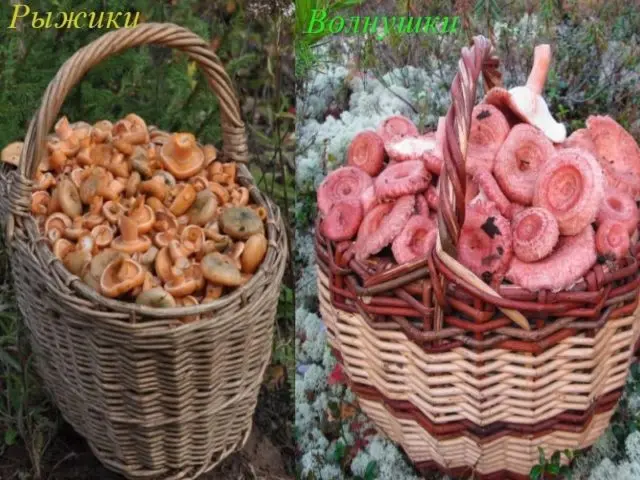
How to distinguish between mushrooms and waves when collecting
Having listed the similarities between the saffron milk cap and the wave, it is necessary to summarize the differences between them:
- upon closer examination, specific features in external details become noticeable: the color and shape of the cap and stem, the texture of the integumentary skin, the degree of severity of the pattern of circles;
- sometimes the size can serve as a hint – the saffron milk cap is usually a little larger;
- they are common in different places and “love” different trees: as a rule, you can find volushka under birches and aspens in mixed and deciduous forests, while camelina can be found in coniferous forests with exceptionally clean ecology;
- the pulp and milky juice of these mushrooms differ in color, taste and smell;
- in contrast to the wave, the fruiting body of the camelina at the break changes color, oxidizing in air;
- when boiled or fried, the camelina darkens, and the wave becomes light gray;
- the taste and aroma of camelina is much richer;
- before preparing the waves, they must first be soaked for a long time, and then boiled, draining the first water, mushrooms almost do not need pre-treatment;
- mushrooms can be successfully cooked in almost any form, volnushki are most often salted and marinated.
Conclusion
The difference between saffron mushrooms and mushrooms is not particularly noticeable at first glance, and therefore inexperienced mushroom pickers often confuse them. However, if you take a closer look, and also remember a number of signs by which each of them can be recognized, it will not be so difficult to figure out which of these mushrooms was found. Despite the fact that volushki can also be eaten, they require mandatory and rather lengthy pre-treatment in order to eliminate bitterness and toxic substances. In addition, these mushrooms are not suitable for all dishes. It is much easier to cook mushrooms, they are more fragrant and tastier, but they are much harder to find in the forest.










